Mother Nature’s subterranean world of caves is one of the most intriguing and mysterious natural wonders to explore. From the Caribbean to Europe and Asia, there’s no shortage of amazing caves to marvel at on your travels.
Spark your inner explorer with a thrilling expedition diving or snorkeling inside sea caves, trekking in the Arctic’s ice caves, hiking to hidden caverns, or boating into impossibly blue water in the Mediterranean.
However you choose to explore the world’s caves, there’s one thing for sure—they’ll take your breath away. These are some of the best caves in the world.
The Crystal Caves, Bermuda
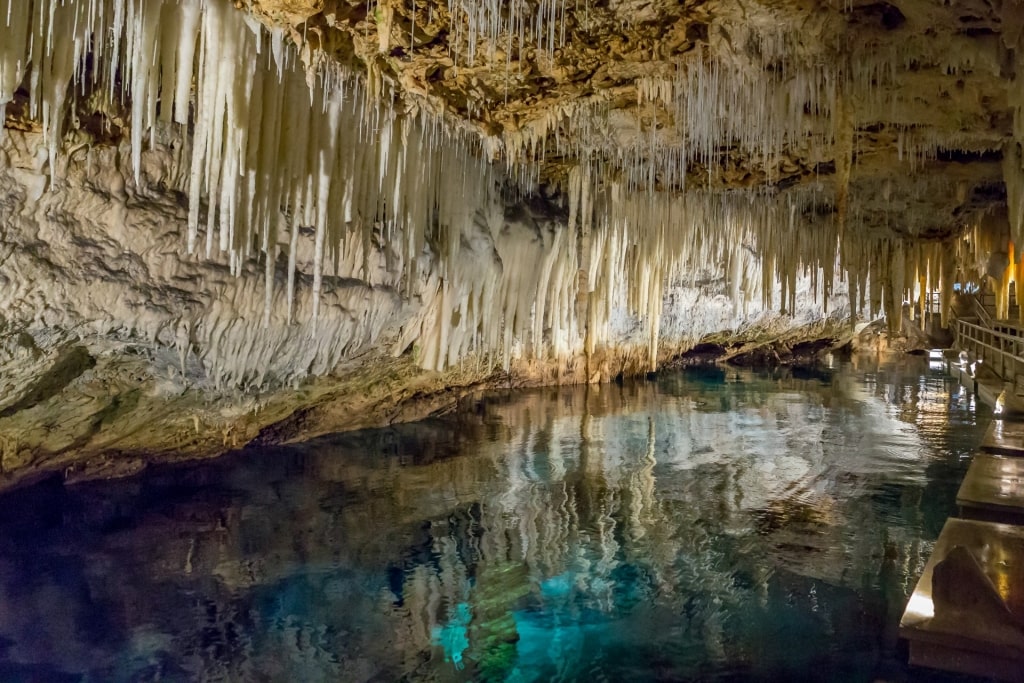
The Crystal Caves, Bermuda
Discover the natural treasures of Bermuda with this cave duo, the Crystal and Fantasy Caves. One of the island’s largest cave systems, The Crystal Caves are a must-see, found approximately 120 feet below the surface.
You’ll quickly understand how they received their names from the chandelier-like rock formations on the cave ceilings.
Located near Castle Harbour in Hamilton Parish, the nearly 1,700-foot-long cave system is filled with giant stalagmites, stalactites, and crystal-clear pools of deep water within its underground limestone caverns.
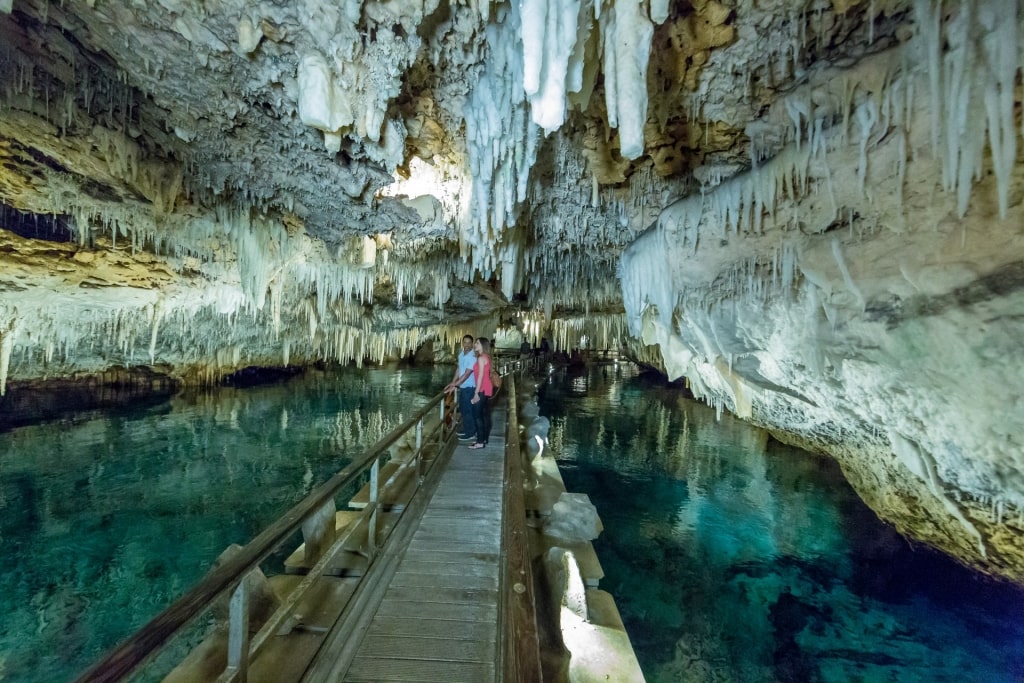
The Crystal Caves, Bermuda
Venturing into these beautiful caves is one of the most unique things to do in Bermuda. Explore one cave, or both, with Crystal Cave being first and then Fantasy Cave situated 88 steps further below.
Cross a floating bridge that changes in height with the tides, as you marvel over the vibrant azure water of the pools and dripping stalagmites from above. The bridge spans Cahow Lake, more than 50 feet deep, a pristine blue wonder within the cave system.
Blue Grotto, Sicily, Italy
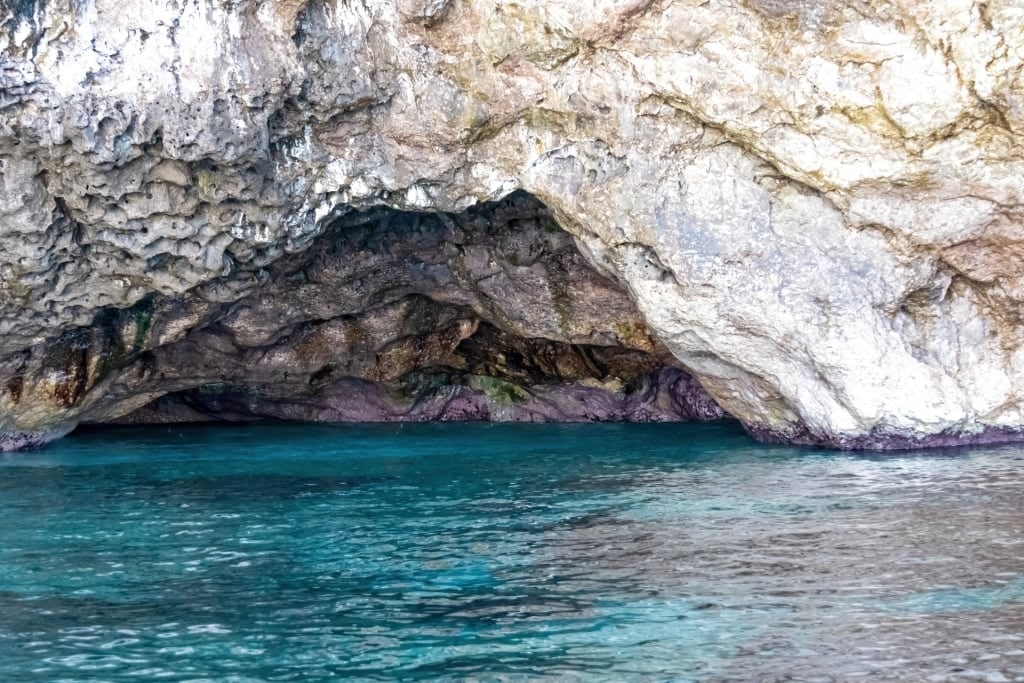
Blue Grotto in Sicily, Italy
Italy is filled with natural treasures, from mountains to the sea. One of the top wonders is the Blue Grotto, located near Taormina, Sicily, and accessible by boat.
Referred to as the “Grotto Azzurra” in Italian, local sailors once believed it to be haunted by monsters. Now, this fascinating cave draws visitors to the Ionian Sea, in the Marine Park of Isola Bella, an island off the southern coast of Sicily.
This sea cave is regarded as one of the top natural attractions on the island’s shores.
Boat tours from harbor below the enchanting village of Taormina will take you to see this awe-inspiring cave, where the light reflects into the water, creating some of the most vibrant blue coloring you’ve ever seen.
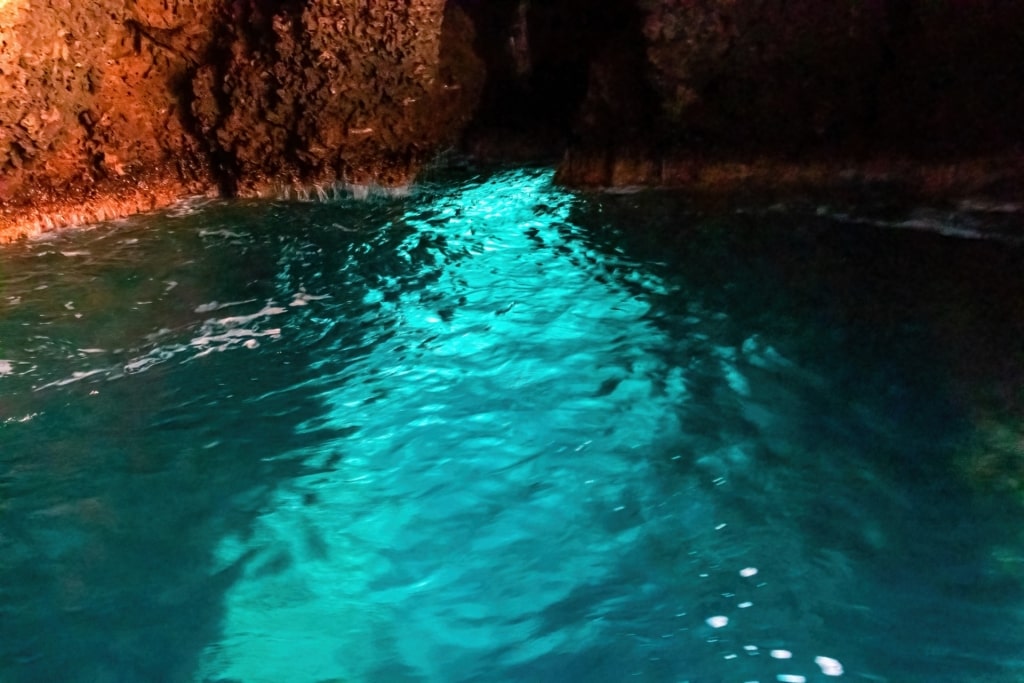
Blue Grotto in Sicily, Italy
You’ll have to duck down for the grand entrance to this natural cavern, as the boat navigates through a small opening. From there, you’ll be transported into what seems like a different world, with a large open cave and shimmering water.
This is a popular spot for photographers attempting to capture the magic of the Italian coast. Scuba divers also frequent the Blue Grotto, for a chance to explore crystal clear water and see marine life such as coral, shrimp, rainbow fish, and eels.
Ruakuri Caves, near Auckland, New Zealand
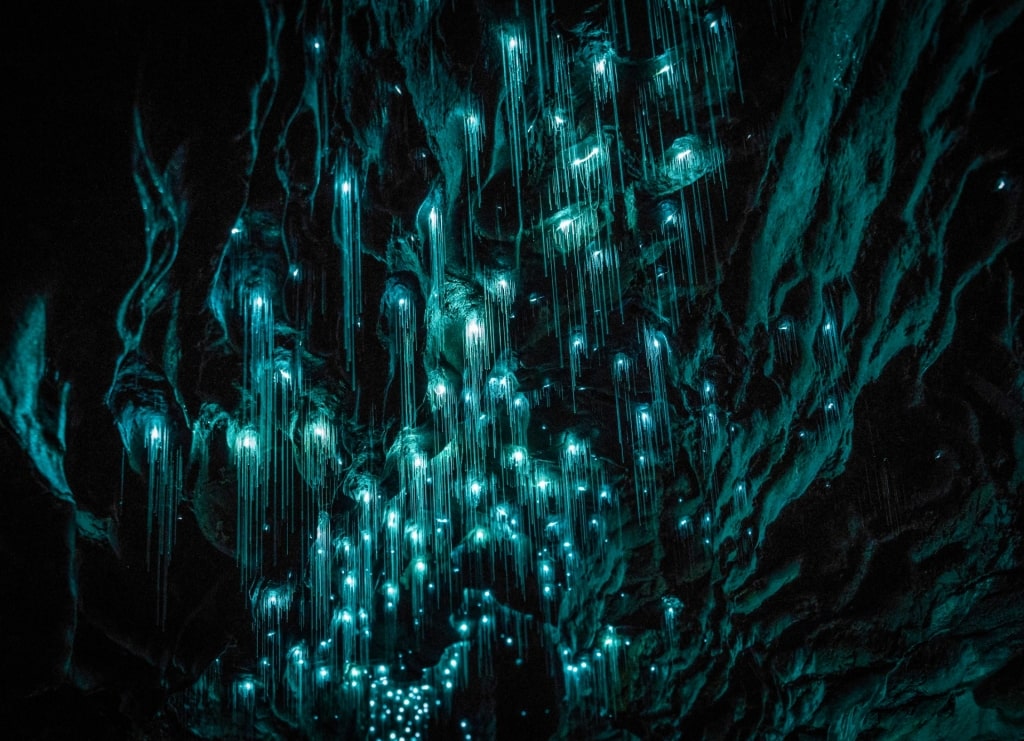
Ruakuri Caves, near Auckland, New Zealand
See the famous glow worms of New Zealand with a visit to the Ruakuri Caves, located a couple of hours south of Auckland. Within the Waitomo cave system, the natural phenomenon of glowing fauna draws visitors to view the breathtaking scene that’s famous around the world.
Embark on New Zealand’s longest guided underground walking tour, where you’ll start at the dramatic spiral stair entrance to go down into the subterranean world where limestone rock formations, waterfalls, and hundreds of thousands of glow worms await.
Take photographs and marvel at the experience of getting up close to the bioluminescent creatures, pinpricks of light in the darkness.
Postojna Cave, near Koper, Slovenia
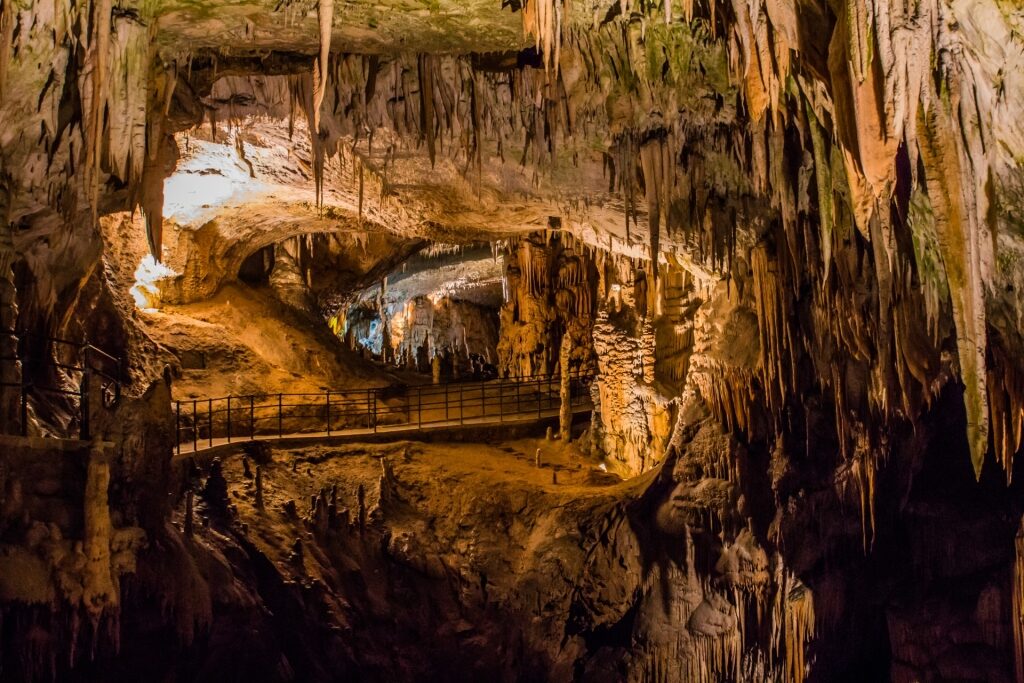
Postojna Cave, near Koper, Slovenia
Slovenia is known for its untouched and beautiful alpine landscape, and other striking natural wonders.
One of them is the Postojna Cave, located less than an hour’s drive from the coastal city of Koper. Known as the second-longest cave system in Slovenia, it’s so massive that you can take a scenic train ride through it.
Created by the Pivka River, the cave system has been forming for millions of years and is made up of four interconnected caves.
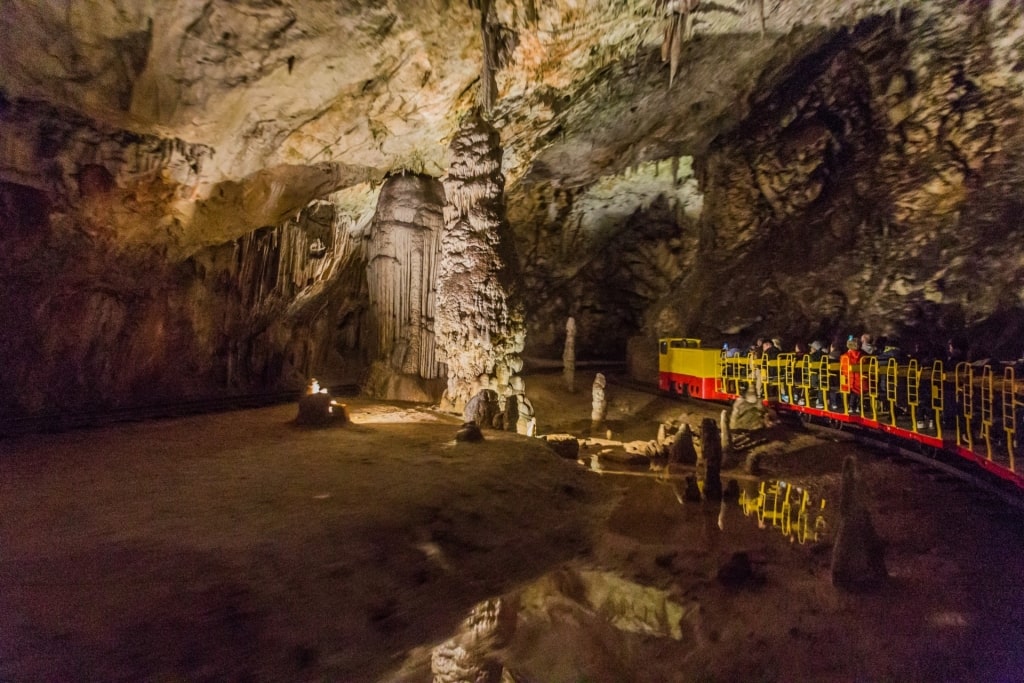
Postojna Cave, near Koper, Slovenia
Here, you can marvel at stalagmites, stalactites, and limestone rock formations called “curtains.” Tour the three-mile length of caves, the only portion open to the public.
View the concert hall, a cavernous space where musical and other performances are held, the Tube hall, and Big Mountain Hall, among other highlights.
Nerja Caves, Malaga, Spain
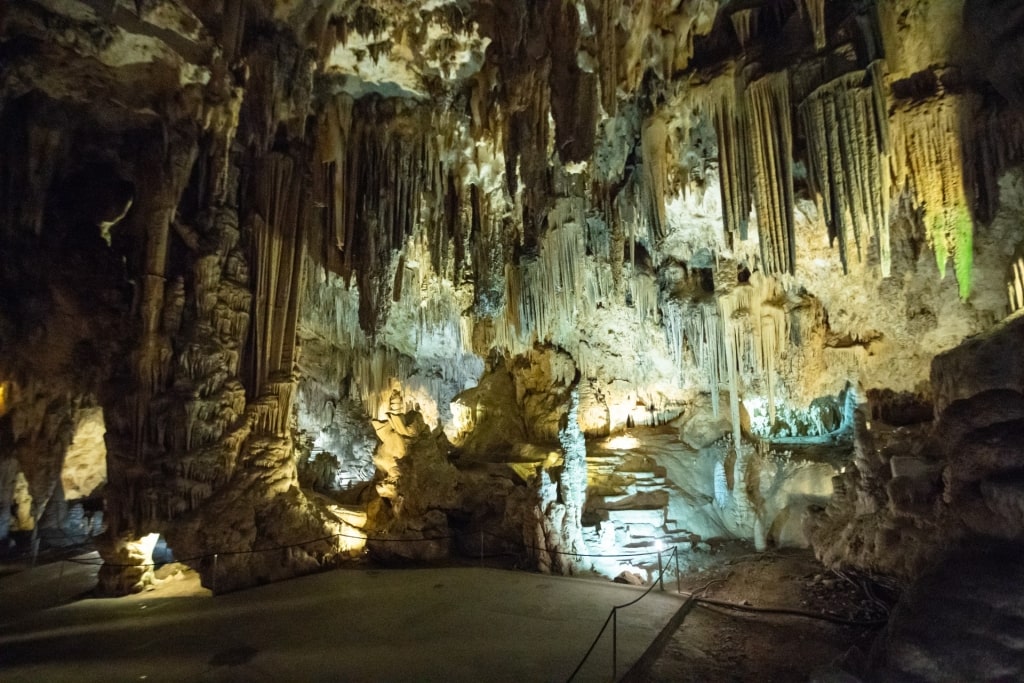
Nerja Caves in Malaga, Spain
Located approximately 45 minutes east of Malaga, the Nerja cave system was discovered in 1959 by a group of locals exploring the area. Now, the caves are considered a Historical Artistic Monument, and one of the region’s most impressive natural attractions.
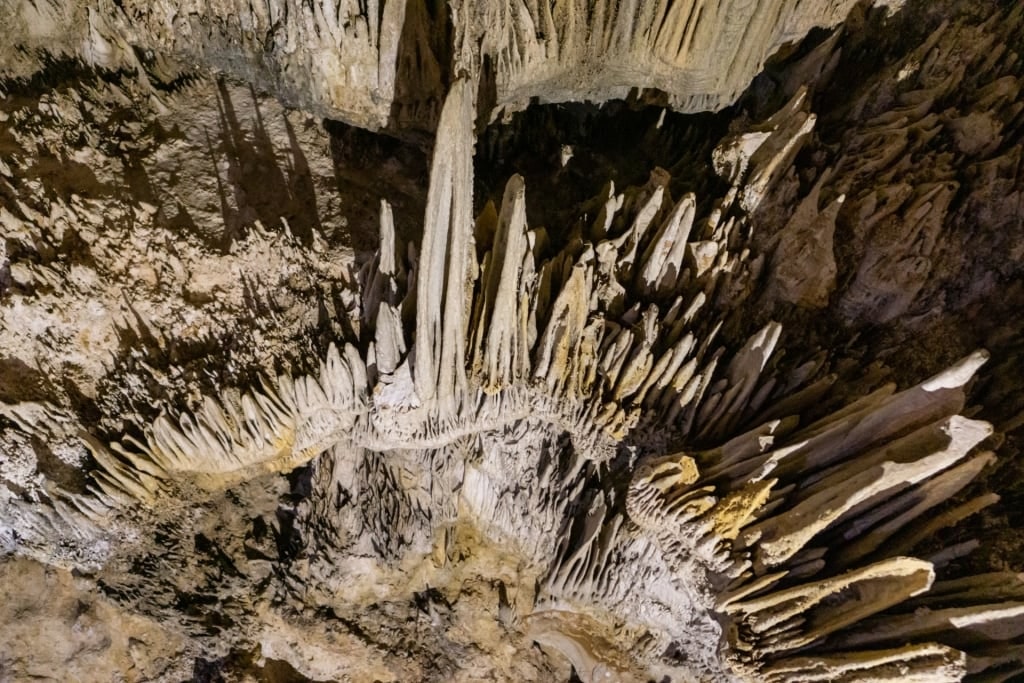
Nerja Caves in Malaga, Spain
The series of three caverns, or “galleries” stretches just over three miles and is filled with various halls, giant rock formations, columns, spirals, stalagmites and stalactites.
The Show Gallery forms a natural amphitheater and is host to concerts throughout the year, a unique and atmospheric experience for guests. Paleolithic and post-Paleolithic cave paintings were discovered here, too; there’s thought to be 589 of these within the Upper and New Galleries, although they are not currently accessible to visitors.
Take the road train from the center of Nerja, a busy seaside resort, to reach the Nerja Caves.
Lipa Cave, near Kotor, Montenegro
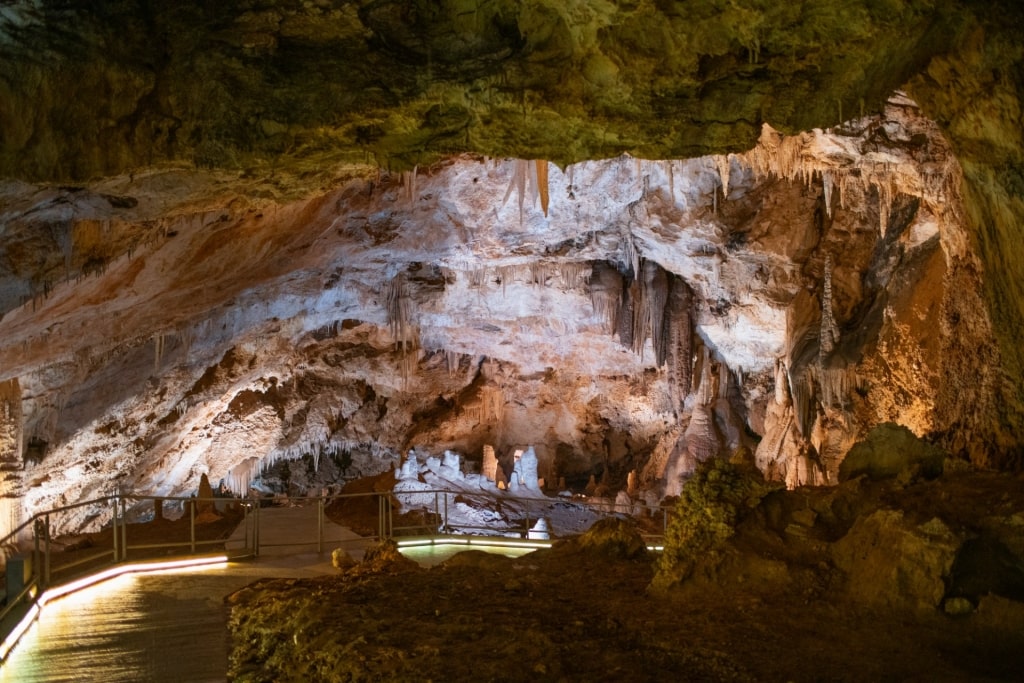
Lipa Cave, near Kotor, Montenegro
Visit one of Montenegro’s largest cave systems, located about an hour from Kotor. The large karst cave network was discovered by accident in the 19th century and has been explored by experts and adventurers.
It’s been open for tours since 2015 and offers visitors the chance to wander more than a mile and a half of passageways, among mesmerizing stalagmites, stalactites, rock pillars, and an underground river.
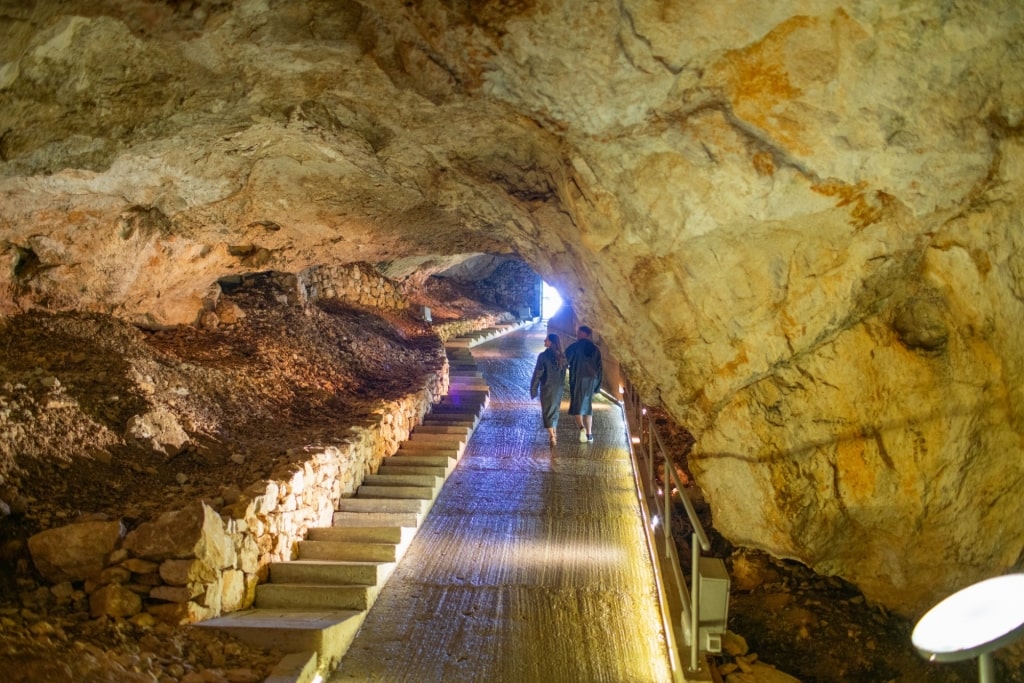
Lipa Cave, near Kotor, Montenegro
Take the small train from the ticket office and café area to the cave entrance where you’ll embark on your underground adventure. Learn about the cave’s formation and history while exploring the underground world on designated paths, with a knowledgeable guide.
Read: Best Things to Do in Kotor, Montenegro
Blue Grotto, Malta
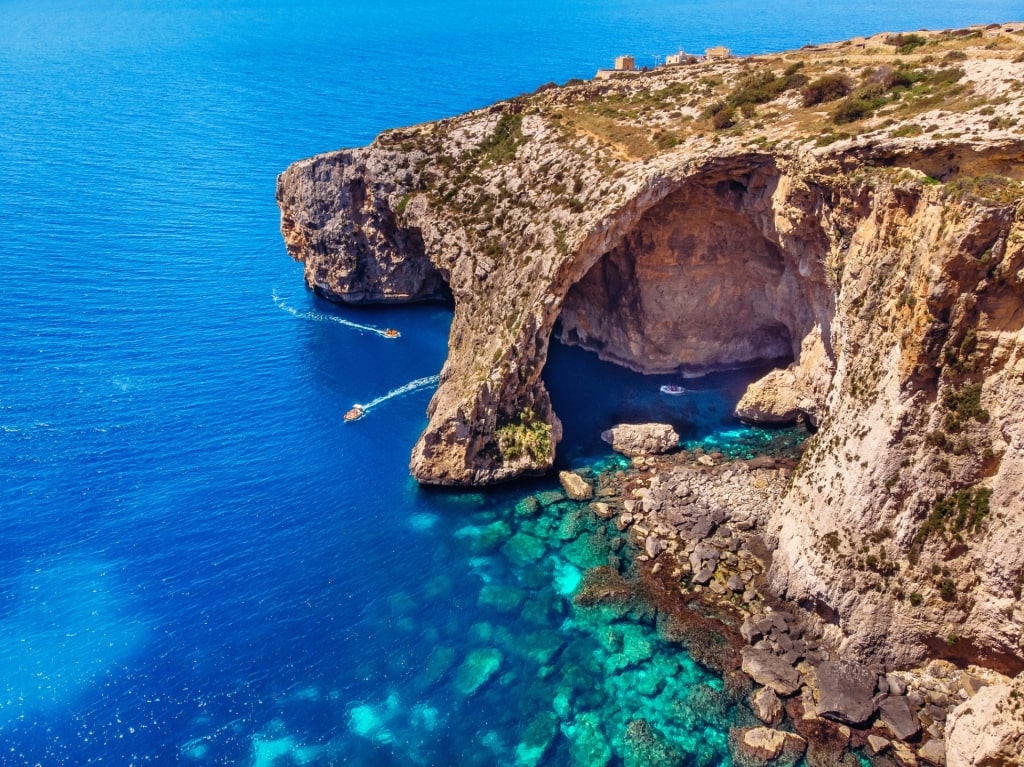
Blue Grotto, Malta
On the southern coast of Malta, the Blue Grotto is one of the island’s best-loved natural attractions. The collection of sea caves is dramatic, and best seen by boat tour.
The name comes from the bright shades of azure blue that appear when the sunlight hits the water in the afternoon, reflecting off the white sandy bottom of the ocean. Its name was given by a British soldier who visited in the 1950s said it was very similar to the Grotta Azzurra in Capri, which, translated, means “Blue Grotto.”
The dramatic main arch is one of the most notable features in this collection of six caves, soaring almost 100 feet high. Formed by the crashing waves of the sea, the complex of caves and rock formations is a sight to behold.
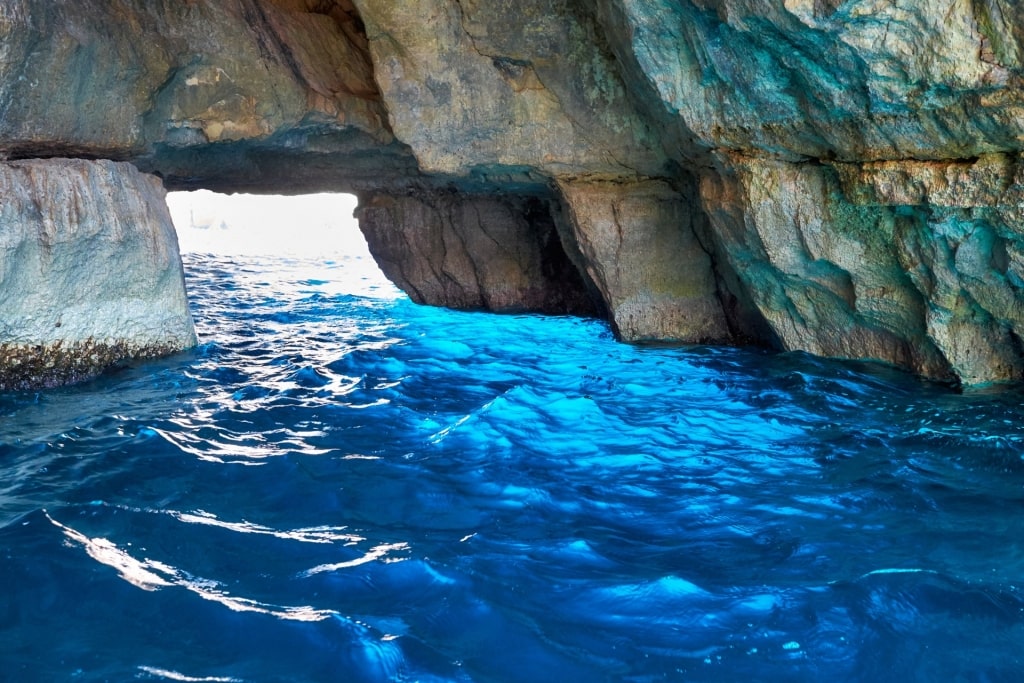
Blue Grotto, Malta
Inside the caves, other colors such as green, orange, and purple appear to be mirrored on the limestone cliff walls from the underwater flora, to add to the allure.
Enjoy a boat tour to the awe-inspiring Blue Grotto and then take in the view from a different perspective, high above the sea from the nearby overlook, accessed by a walking path from the bus stop.
Sung Sot Cave, Halong Bay, Vietnam
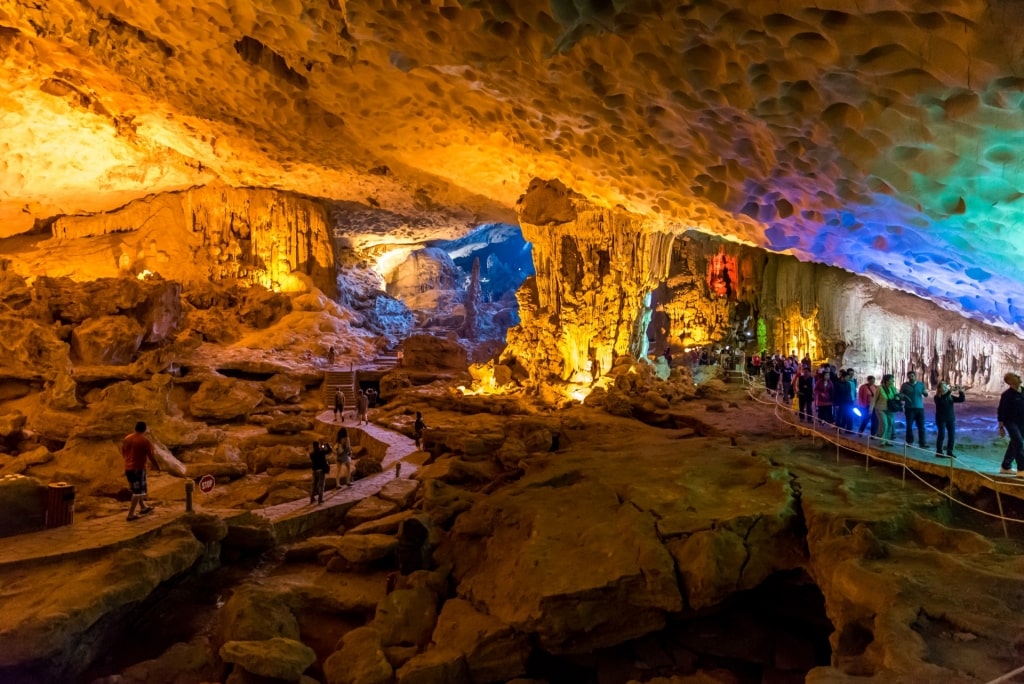
Sung Sot Cave in Halong Bay, Vietnam
Meaning “Surprise Cave,” Sung Sot Cave is the largest of its kind in Vietnam’s scenic Halong Bay.
Situated on Bo Hon Island, this massive cave is a highlight on most Halong Bay tours. It’s considered the center of the Halong Bay UNESCO World Heritage Site.
Sung Sot is made up of two large chambers, one deemed “The Waiting Room,” and the other, “The Serene Castle.”
The Waiting Room is a large space with colorfully lit walkways where you can wander the paths and admire the stalagmites and stalactites. The Serene Castle is accessed by a narrow passageway that then opens up to a vast cavern with a high ceiling.
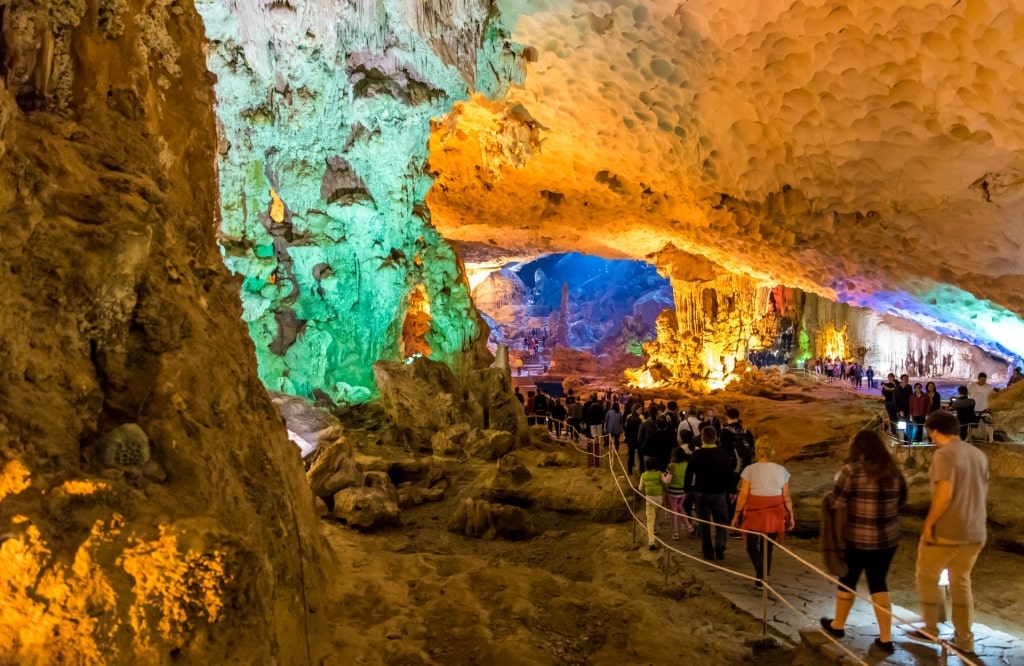
Sung Sot Cave in Halong Bay, Vietnam
Here, you can marvel at the rock formations said to resemble many different types of animals. Make sure to view the most famous of the rock formations, in the shape of a horse and a sword, that’s said to represent the legendary local protector, Thanh Giong.
Langjökull Ice Cave, Iceland

Langjökull Ice Cave, Iceland
A visit to the Langjökuoll Glacier, Iceland’s second longest, is a unique opportunity to venture under the ice. It’s an otherworldly scene of ice caves, hand-carved passageways, an ice chapel, rushing, under-the-ice rivers and dark waterfalls tumbling inside the glacier.
The tunnel under the glacier was created by some enterprising locals, and as the glacier is moving, has to be maintained every year. You’ll access the unassuming entrance via specially adapted trucks, with giant tires that can grip the ice as you drive over the surface of the glacier.
The tunnel emerges into the spectacular Langjökull Ice Cave, again, man-made, but shaped by nature. Stand in the cave, take in the silence, with the only sound a drip-drip-drip of glacial water, and the knowledge that the ice above your head is 82 feet thick—and the ice below your feet, 250 feet deep.
Read: Experience Iceland’s Nature at These Incredible Sites
Crystal Caves, Belize
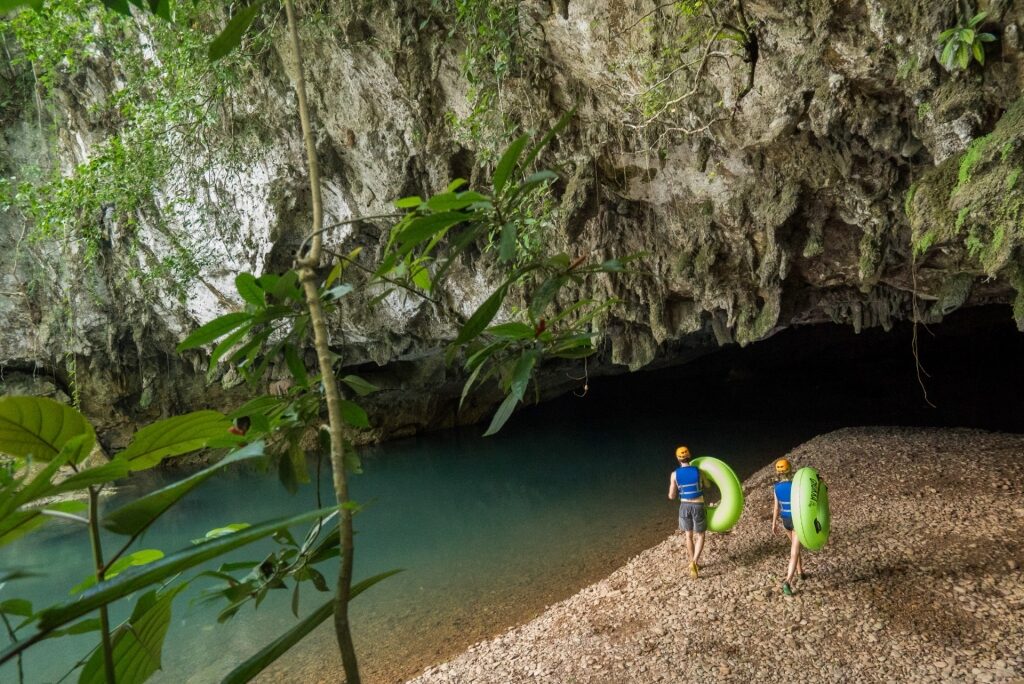
Crystal Caves, Belize
Found within Blue Hole National Park, Crystal Caves is one of the largest cave systems in Belize. Moderate hiking is required to access this cave, first through the jungle, and then through the narrow cave entrance to the underground caverns.
You’ll be transported into the vast cave system with rock columns, stalactites, stalagmites, flowstones, and the crystalline formations the caves are named for. There are even ancient Mayan artifacts that can be seen while exploring the crystal caves.
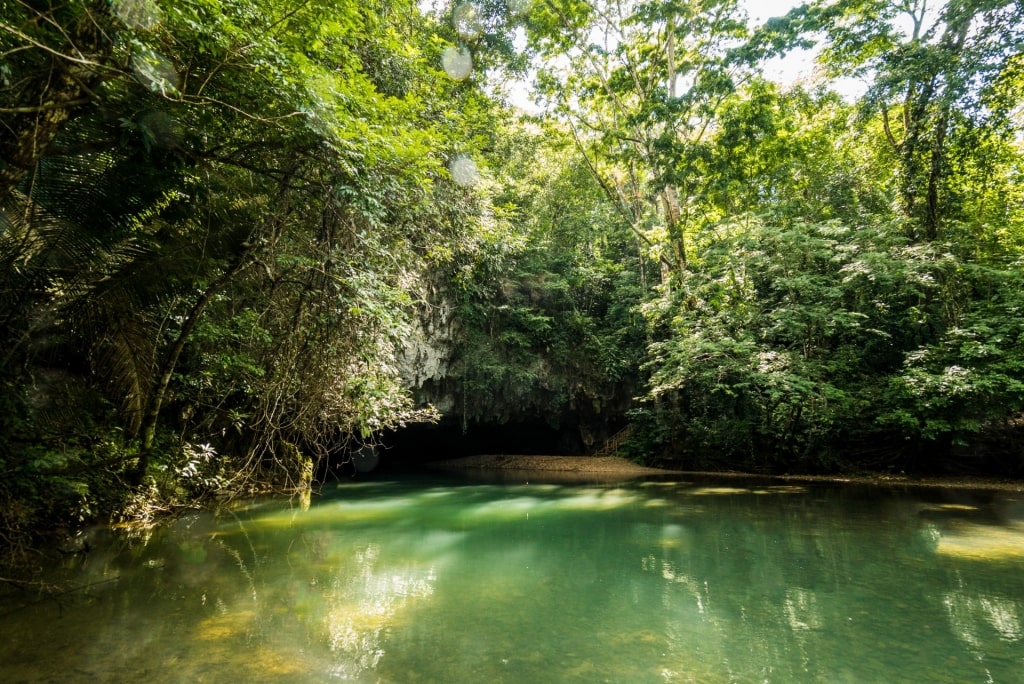
Crystal Caves, Belize
The main cave was once used by Mayan shamans for ancient ritual ceremonies, and artifacts like fire pits, charcoal pieces, beads, and ceramics are among the impressive crystal formations found within this space.
The combination of natural wonders, ancient history, and culture make this one of the most amazing cave systems in the world and an unforgettable Belizean adventure.
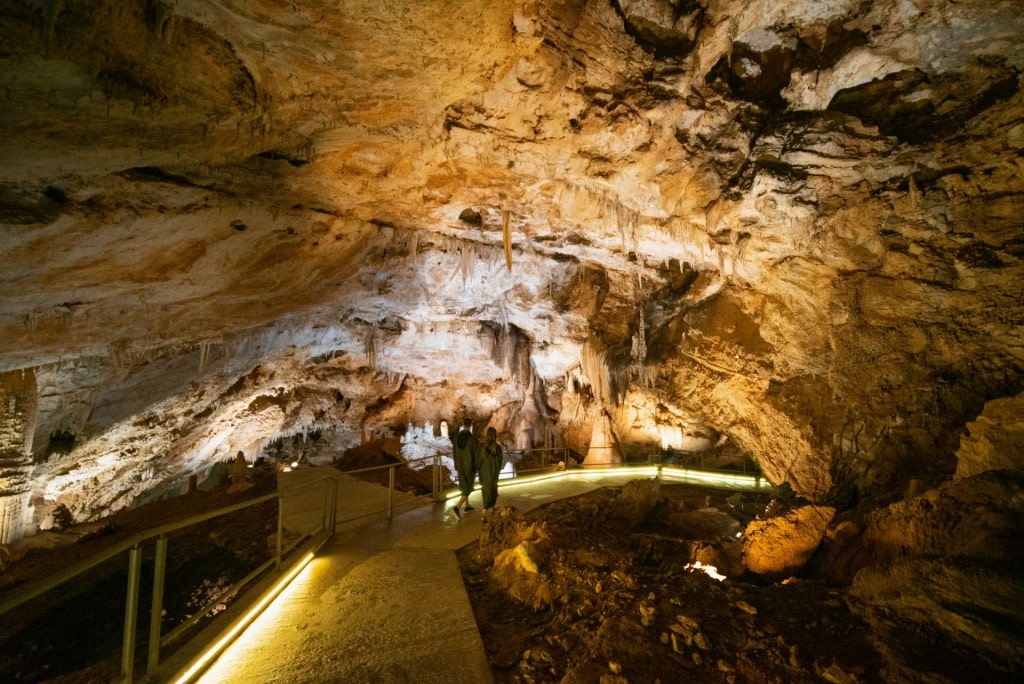
Lipa Cave, near Kotor, Montenegro
From ice caves to sea caves and everything in between, a chance to see the subterranean world is a memorable travel experience. A cruise is a fantastic way to reach some of the best caves in the world.
Browse itineraries and book your vacation today to explore the underground world of beautiful caves.



